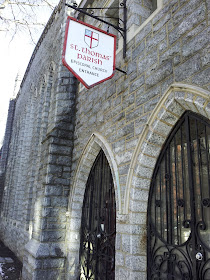An publicly-available email sent to D.C.'s
Board of Zoning Adjustment (BZA) quoted a neighbor who said: "...they are slumlords, and everything is just a smokescreen, and a reason just to get residents out of the building."
 |
| 2724 11th Street (Google Street View) |
"If the building is not in good shape, it's your fault," a member of the Design Review Committee of Advisory Neighborhood Commission (ANC)
1B/U Street told the owners of 2724 11th Street NW, and their representatives, at a regular monthly meeting on June 17.
"It is in desperate need of repair," said ANC1B Chair James Turner (Commissioner for district 09) at the same meeting.
The petitioners who came before the Design Review Committee in search of endorsement of two zoning
variances are not getting a lot of love from the community, or the ANC.
Their BZA hearing is July 22nd. They had entertained the hope the committee would recommend endorsement to the full ANC, who would then vote on the matter at its next regularly-scheduled meeting (July 10, 7pm, at the Reeves Center, 14th and U Streets). But the committee decided to table the matter and asked for an improved design at the next meeting. Even if the new design is produced and approved at a July meeting, the full ANC would not vote on it until August, at the earliest.
The building was built in 1923 and is located at the corner of 11th and Girard Streets. It was said at the meeting that the property has been managed by the same family since 1958. The name of the management company today is Jefferson-11th Street, LLC. This company is, in turn, owned and managed by the family-owned Hartford E. Bealer Development Company, according to BZA documents. At the meeting, representatives of the owners said this was the first major renovation of this building in 50 years.
A
2003 obituary describes Hartford E. Bealer as a "prominent figure in the world of investment banking" and a co-founder and president of
Chevy Chase Bank.
Another web site says that, when Bealer died, his estate was worth more than $22 million.
However, at the meeting, a family member said: "We are not made of money."
"There have been some bad decisions," she said, especially by her 83-year-old father-in-law.
The desired variances
The building is a two-story building with 12 units on each
floor. The owners wish to fill in and improve the unfinished basement
and turn it into 11 additional units.
The zoning variances necessary to do this will be (1) permission not to provide at least 4 additional parking spaces, and (2) permission not to meet the requirement that residential units in this zoning category be at least 900 square feet.
Martin Sullivan of the law firm
Sullivan & Barros led the team of petitioners. Sullivan proposed that, if the ANC was against the parking variance, ANC could endorse a request for a curb cut, which would allow tenant access to on-property parking.
"The community is outraged about the curb cut," ANC Chair Turner said. "They would rather have the parking variance."
2724 11th Street is in Turner's ANC district.
Payback time for the community
In addition to the comments quoted at the beginning of this post, there was plenty of other evidence that the petitioners had few friends in the community.
A renovation had apparently been started at the building in the recent past and then was abruptly stopped when it was discovered that the contractor had not obtained necessary permissions, nor notified the neighbors.
"Once we found out the contractor had no permissions, we fired him," Sullivan said.
A hole in the ground remains.
"It's an issue for me as a safety issue," said one committee member.
Referring to the abandoned project, another committee member said: "I have even less confidence in you if you can't do this correctly."
Sullivan defended the owners.
"It's subject to rent control," he said. "It's way below market rate for existing tenants."
Sullivan said, under rent control, a 10% increase in rent is only possible when a tenant leaves.
According to both information presented at the meeting and in the BZA application, the owners have submitted a "hardship petition" that will allow rents to rise by 31.5%. The owners were previously granted an 31.5% increase but "the notices didn't go out". They now must re-apply.
"All tenants will be hit with a 31 percent increase?" a committee member asked.
"Yes," Sullivan said.
However, according to a zoning application document signed by Sullivan, even if the hardship application is granted, the owners "will not realize anything near market value" on the existing units.
All of the proposed new units will be rented at market rate, after which they will also be subject to rent control.
Documents pertaining to this case, including the email quoted at the top of this post, can be accessed by going the BZA's
Interactive Zoning Information System and entering case number 18790 in the search bar.


















